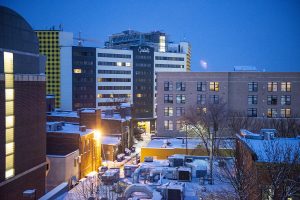City Council discusses concerns surrounding Mormon Trek lane reduction
In a work session on Feb. 19, the council discussed converting a portion of Mormon Trek Boulevard from four to three lanes and addressed concerns that the transition would slow traffic.
The council deliberates at a meeting of the Iowa City Council on February 19, 2019
February 19, 2019
The Iowa City City Council on Feb. 19 discussed a plan for converting a portion of Mormon Trek Boulevard from a four-lane to a three-lane street.
In the proposal, two traffic lanes would run in opposite directions, and the lane in the middle would be a designated left-turn lane for both directions.
The goal is to decrease the number of traffic accidents on the street.
According to a video from the Iowa Department of Transportation shown at the meeting, traffic accidents on four-lane roads often happen at unregulated intersections, because cars turning left have low visibility and often slow down abruptly.
According to the Iowa DOT, four-to-three lane reductions have reduced traffic accidents by 47 percent in the state.
In a study of traffic accidents on Mormon Trek from 2011 to 2015, 56 of 126 accidents could perhaps have been prevented with a three-lane street, City Manager Geoff Fruin said.
A traffic study of Mormon Trek performed by Snyder & Associates on Jan. 12, 2016, concluded that traffic volume along the corridor was light enough to warrant a conversion to a three-lane street.
“The current and forecast traffic volumes for the corridor are within the limits of what a three-lane roadway can typically accommodate with acceptable user delay,” the report said.
RELATED: Iowa City City Council passes resolution of support for UI Labor Center
Despite the proposed increase in safety, some community members have voiced concerns about the possibility of the transition causing unintended delays in traffic.
The 2016 study was performed while the UI students were on winter break. Some community members thought the absence of students caused the traffic volume to be less than it would be generally.
“I’m immediately suspect of the accuracy of this report and the resulting conclusions …” Iowa City resident Brenda Kurtz said in a memo to the council. “The study could have at least been done at the end of the month to capture relevant vehicle volume, including bus use.”
A similar conversion has been done on First Avenue, which has received some pushback from the community.
“We have a lot of people on the East Side that don’t like the four-to-three on First Avenue,” Councilor Susan Mims said.
Councilors expressed interest in performing more studies on the traffic density of the corridor before moving ahead with the project. The city estimates the conversion would only slow traffic by around 30 seconds.
“I think we’re going into this project acknowledging we’re trading off safety for travel time,” Fruin said. “Even if it’s 30 seconds, we are slowing traffic down in the corridor in exchange for, hopefully, reducing accidents.”
After discussing concerns about the project, the council decided to continue with the plans with a re-evaluation on the project’s effectiveness in the future.
A lane conversion will likely take place in late spring, city senior civil engineer Scott Sovers said.
“I think [the council’s plan] is just to review the study that we have on hand and make sure it’s still valid,” Sovers said.






